-
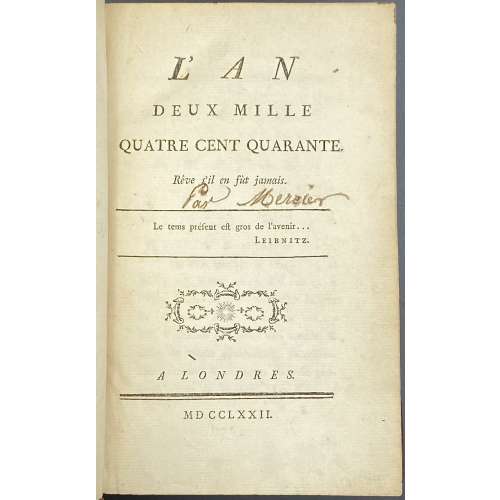 Title page: L'AN DEUX MILLE QUATRE CENT QUARANTE. | Rêve s'il en fût jamais. | Le temps présent est gros de l'avenir... | Leibnitz. | {letterpress device} | A LONDRES. | MD CCLXXII. || Pagination: [i-iv] v-xii, 1-402 [2]; Collation: 8vo; π6 A-Z8 Aa-Bb8 Cc2. Binding: 19 x 12 cm, full mottled calf, rebacked, spine with gilt-lettered red label, compartments ruled gilt, with gilt fleuron ornament, marbled endpapers and all edges; printed on laid paper, with tall “s”. Probably published in Paris, anonymously. Handwritten nut-ink inscription to the title "Par Mercier". See also: LIB-0979.2016
Title page: L'AN DEUX MILLE QUATRE CENT QUARANTE. | Rêve s'il en fût jamais. | Le temps présent est gros de l'avenir... | Leibnitz. | {letterpress device} | A LONDRES. | MD CCLXXII. || Pagination: [i-iv] v-xii, 1-402 [2]; Collation: 8vo; π6 A-Z8 Aa-Bb8 Cc2. Binding: 19 x 12 cm, full mottled calf, rebacked, spine with gilt-lettered red label, compartments ruled gilt, with gilt fleuron ornament, marbled endpapers and all edges; printed on laid paper, with tall “s”. Probably published in Paris, anonymously. Handwritten nut-ink inscription to the title "Par Mercier". See also: LIB-0979.2016 -
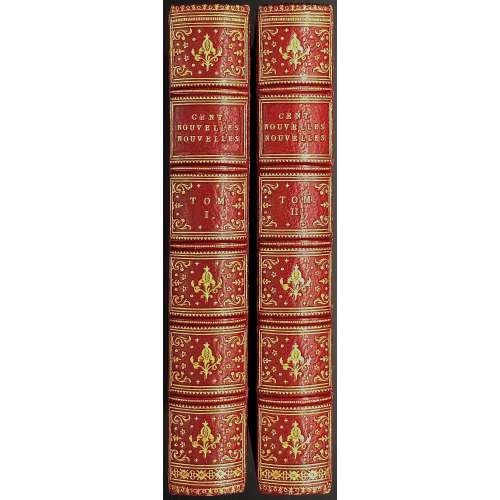 Description: Two volumes, 16.5 x 11 cm, collated 8vo, uniformly bound in the mid-19th century by H. Stamper (stamp to verso free endpaper) in red Morocco, ornated with gilt fillets and dentelles to boards and turn-ins, spine with raised bands and gilt decorations and lettering in compartments, marbled endpapers, all edges gilt; printed on laid paper; bookplate to front pastedown “EX LIBRIS | DANIEL | BERDITCHEVSKY”. Title-page (red and black, tall ‘s’): LES CENT | NOUVELLES | NOUVELLES. | SUIVENT LES CENT NOUVELLES | CONTENANT | Les Cent Histoires Nouveaux, | Qui sont moult plaisans a raconter, | En toutes bonnes Compagnies, | Par MANIERE DE JOYEUSETÉ. | Avec d'excellentes Figures en Taille-douce, | Gravées sur les desseins du fameux Mr. | ROMAIN DE HOOGE | & retouchées par feu | B. PICART LE ROMAIN | TOME PREMIER (TOME SECOND) |{device} | A COLOGNE | Chez Pierre Gaillard. | M.DCCXXXVI. || Vol. 1: Collation: [1] flyleaf torn out, [1] frontispiece, [1] title-page, [3] preface (*2-4), [1] Auertissement, [10] table (2+**-**8), A-Bb8 (Bb8 blank); 45 in-text half-page copperplate etchings by various engravers after Romain de Hooge; total 215 leaves plus ffl and frontispiece by Gilliam van der Gouwen after Romain de Hooge. Pagination (starting from t.p.): [30] 1-397 [398] [2], total 430 pages. Vol. 2: Collation: ffl, [*1] t.p., [11] table (*2-8, **-4), A-Aa8 Bb4 (Bb4 blank); 55 in-text half-page copperplate etchings by various engravers after Romain de Hooge; total 208 leaves plus ffl. Pagination: [24] 1-389 [390] [2], total 416 pages. Catalogue raisonné: Landwehr (1970) № 94, p. 203; Lewine (1898) p. 326; Cohen-DeRicci (1912) p. 658. Landwehr cites two editions after the 1st of 1701: Amsterdam 1732 and Cologne 1786 [i.e. 1736]. Both Lewine and Cohen-DeRicci attribute the text to Louis XI and mention the 1736 reprint (though not 1786). The first edition of “Les cent nouvelles nouvelles” appeared in 1486 by commission of Duke of Burgundy Philippe le Bon; the text is attributed to Philippe Pot (1428 – 1493), Antoine de La Sale (c. 1385 – c. 1460) or King Louis XI (1423 – 1483). Contributors: Artists: Romain de Hooge (Dutch, 1645 – 1708) Bernard Picart (French, 1673 – 1733) Engravers: Gilliam van der Gouwen (Dutch, c. 1657 – 1716) (frontispiece) Laurens Scherm (Dutch, fl. 1689 – 1701) (nouvelles XXIX, XXX, LXXVII) Jan Van Vianen (Dutch, c.1660 – 1726?) (nouvelles L, LII, LVII-LX, LXIV-LXVII, LXX) Binder: Henry Stamper (British, 1802? – 1887) Commissioner: Philippe le Bon [Philip III] (French, 1396 – 1467) Publisher: Pierre Gaillard (French, fl. 1715 – 1737)
Description: Two volumes, 16.5 x 11 cm, collated 8vo, uniformly bound in the mid-19th century by H. Stamper (stamp to verso free endpaper) in red Morocco, ornated with gilt fillets and dentelles to boards and turn-ins, spine with raised bands and gilt decorations and lettering in compartments, marbled endpapers, all edges gilt; printed on laid paper; bookplate to front pastedown “EX LIBRIS | DANIEL | BERDITCHEVSKY”. Title-page (red and black, tall ‘s’): LES CENT | NOUVELLES | NOUVELLES. | SUIVENT LES CENT NOUVELLES | CONTENANT | Les Cent Histoires Nouveaux, | Qui sont moult plaisans a raconter, | En toutes bonnes Compagnies, | Par MANIERE DE JOYEUSETÉ. | Avec d'excellentes Figures en Taille-douce, | Gravées sur les desseins du fameux Mr. | ROMAIN DE HOOGE | & retouchées par feu | B. PICART LE ROMAIN | TOME PREMIER (TOME SECOND) |{device} | A COLOGNE | Chez Pierre Gaillard. | M.DCCXXXVI. || Vol. 1: Collation: [1] flyleaf torn out, [1] frontispiece, [1] title-page, [3] preface (*2-4), [1] Auertissement, [10] table (2+**-**8), A-Bb8 (Bb8 blank); 45 in-text half-page copperplate etchings by various engravers after Romain de Hooge; total 215 leaves plus ffl and frontispiece by Gilliam van der Gouwen after Romain de Hooge. Pagination (starting from t.p.): [30] 1-397 [398] [2], total 430 pages. Vol. 2: Collation: ffl, [*1] t.p., [11] table (*2-8, **-4), A-Aa8 Bb4 (Bb4 blank); 55 in-text half-page copperplate etchings by various engravers after Romain de Hooge; total 208 leaves plus ffl. Pagination: [24] 1-389 [390] [2], total 416 pages. Catalogue raisonné: Landwehr (1970) № 94, p. 203; Lewine (1898) p. 326; Cohen-DeRicci (1912) p. 658. Landwehr cites two editions after the 1st of 1701: Amsterdam 1732 and Cologne 1786 [i.e. 1736]. Both Lewine and Cohen-DeRicci attribute the text to Louis XI and mention the 1736 reprint (though not 1786). The first edition of “Les cent nouvelles nouvelles” appeared in 1486 by commission of Duke of Burgundy Philippe le Bon; the text is attributed to Philippe Pot (1428 – 1493), Antoine de La Sale (c. 1385 – c. 1460) or King Louis XI (1423 – 1483). Contributors: Artists: Romain de Hooge (Dutch, 1645 – 1708) Bernard Picart (French, 1673 – 1733) Engravers: Gilliam van der Gouwen (Dutch, c. 1657 – 1716) (frontispiece) Laurens Scherm (Dutch, fl. 1689 – 1701) (nouvelles XXIX, XXX, LXXVII) Jan Van Vianen (Dutch, c.1660 – 1726?) (nouvelles L, LII, LVII-LX, LXIV-LXVII, LXX) Binder: Henry Stamper (British, 1802? – 1887) Commissioner: Philippe le Bon [Philip III] (French, 1396 – 1467) Publisher: Pierre Gaillard (French, fl. 1715 – 1737) -
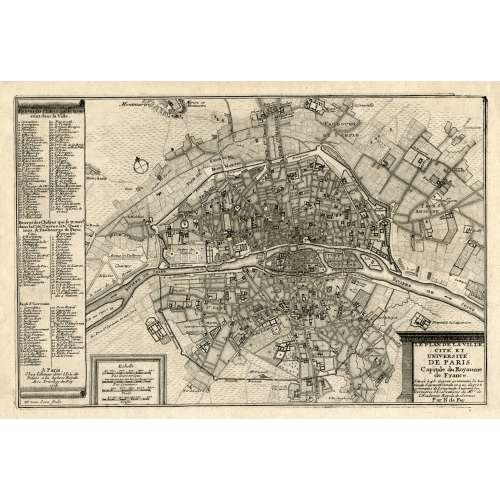 LE PLAN DE LA VILLE, | CITE, ET | UNIVERSITÉ | DE PARIS. | Capitale du Royaume | de France. | {5 lines in italic} | Par N. de Fer. | A Paris, | Chez l’Auteur dans l’Isle du | Palais a la Sphere Royale. | Avec Privilege du Roy. | 1705 | H. van Loon sculp. || Dimensions: Sheet: 27 x 39 cm; Image: 22 x 33 cm. Contributors: Nicolas de Fer (French, 1646 – 1720) – cartographer. Harmanus van Loon (Flemish, fl. c. 1690 – c. 1725) – engraver.
LE PLAN DE LA VILLE, | CITE, ET | UNIVERSITÉ | DE PARIS. | Capitale du Royaume | de France. | {5 lines in italic} | Par N. de Fer. | A Paris, | Chez l’Auteur dans l’Isle du | Palais a la Sphere Royale. | Avec Privilege du Roy. | 1705 | H. van Loon sculp. || Dimensions: Sheet: 27 x 39 cm; Image: 22 x 33 cm. Contributors: Nicolas de Fer (French, 1646 – 1720) – cartographer. Harmanus van Loon (Flemish, fl. c. 1690 – c. 1725) – engraver. -
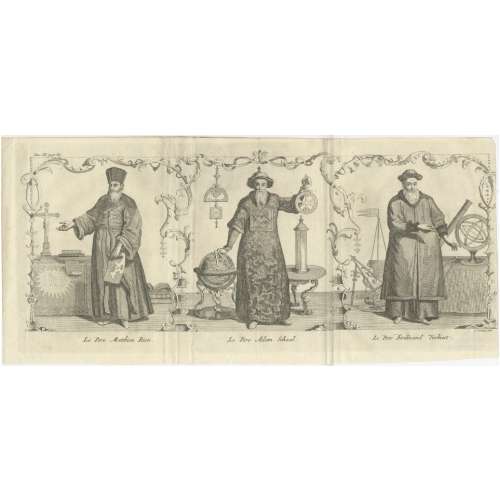
Three priests: Le Pere Matthieu Ricci, Le Pere Adam Schaal, and Le Pere Ferdinand Verbiest. Three priests with navigational instruments. Image taken from Description geographique, historique, chronologique et physique de l'Empire de la Chine et de la Tartarie Chinoise. Enrichies des cartes generales et particulieres de ces pays, etc. by Jean-Baptiste Du Halde (1674–1743), vol. 3, page 78. Originally published/produced in La Haye [The Hague], 1736. J.v.Solingen fecit
Jean-Baptiste Du Halde (Chinese: 杜赫德; 1 February 1674 – 18 August 1743) was a French Jesuit historian specializing in China. He did not travel to China, but collected seventeen Jesuit missionaries' reports and provided an encyclopedic survey of the history, culture and society of China and "Chinese Tartary," that is, Manchuria. Voltaire said of Du Halde's work: "Although it is developed out of Paris, and he hath not known the Chinese, [he] gave on the basis of the memoirs of his colleagues, the widest and the best description the empire of China has had worldwide." Le Pere Matthieu Ricci, a.k.a. Matteo Ricci, S.J. (Italian pronunciation: [matˈtɛːo ˈrittʃi]; Latin: Mattheus Riccius Maceratensis; 6 October 1552 – 11 May 1610), was an Italian Jesuit priest and one of the founding figures of the Jesuit China missions. His 1602 map of the world in Chinese characters introduced the findings of European exploration to East Asia. He is considered a Servant of God by the Roman Catholic Church. Ricci arrived at the Portuguese settlement of Macau in 1582 where he began his missionary work in China. He became the first European to enter the Forbidden City of Beijing in 1601 when invited by the Wanli Emperor, who sought his services in matters such as court astronomy and calendrical science. He converted several prominent Chinese officials to Catholicism, such as Xu Guangqi, who aided in translating Euclid's Elements into Chinese as well as the Confucian classics into Latin for the first time. Le Pere Adam Schaal, a.k.a. Johann Adam Schall von Bell (1 May 1591 – 15 August 1666) was a German Jesuit and astronomer. He spent most of his life as a missionary in China (where he is remembered as "Tang Ruowang") and became an adviser to the Shunzhi Emperor of the Qing dynasty. Le Pere Ferdinand Verbiest, a.k.a. Father Ferdinand Verbiest (9 October 1623 – 28 January 1688) was a Flemish Jesuit missionary in China during the Qing dynasty. He was born in Pittem near Tielt in the County of Flanders (now part of Belgium). He is known as Nan Huairen (南懷仁) in Chinese. He was an accomplished mathematician and astronomer and proved to the court of the Kangxi Emperor that European astronomy was more accurate than Chinese astronomy. He then corrected the Chinese calendar and was later asked to rebuild and re-equip the Beijing Ancient Observatory, being given the role of Head of the Mathematical Board and Director of the Observatory. He became close friends with the Kangxi Emperor, who frequently requested his teaching, in geometry, philosophy and music. Verbiest worked as a diplomat and cartographer, and also as a translator because he spoke Latin, German, Dutch, Spanish, Hebrew, and Italian. He wrote more than thirty books. During the 1670s, Verbiest designed what some claim to be the first ever self-propelled vehicle – many claims this as the world's first automobile, in spite of its small size and the lack of evidence that it was actually built.Joshua Van Solingen was an engraver and publisher from Holland, working, besides other places, in Scotland. Information about him can be found at Catastrophic Bliss (The Griot Project Book Series) by Accounting in Scotland (RLE Accounting): A Historical Bibliography History of the Scottish Metrical Psalms: With an Account of the Paraphrases ... The History of Edinburgh, from the Earliest Accounts to the Present Time ... History of the Bassandyne Bible, the First Printed in Scotland: With Notices ...
-
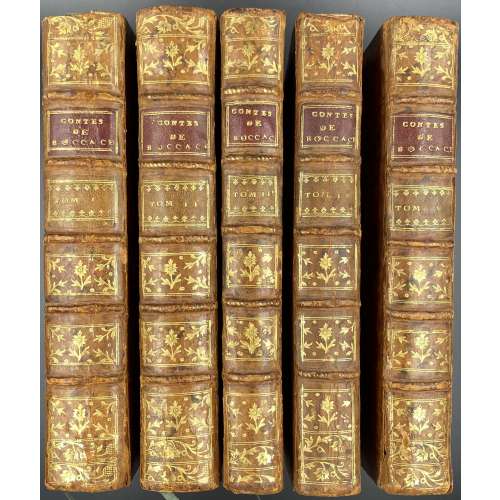 Five volumes, uniformly bound in marbled three-colour stained polished calf, spine with raised bands, gilt in compartments, crimson label with gilt lettering “CONTES DE BOCCACE”, cream label with volume number, marbled endpapers and all edges; bookplate pasted to first blank flyleaf “BIBLIOTHÈQUE DE LAJUDIE” depicting a coat of arms over an anchor, anchors and tulips scattered in the upper section, globe in the lower section, in a frame. Size: 21 x 14 cm. Translated by Antoine Le Maçon (French, 1500? – 1559). Vol. 1: [4] two blank leaves, portrait by Louis Lempereur after Hubert Gravelot, engraved t.p.: LE | DECAMERON | DE JEAN | BOCCACE. | TOME I. | Londres | 1757. | H. Gravelot Inv. […] T.P. N 21 […] J. Aliamet Sculp. ||, engraved frontispiece to Vie de Jean Bocace by Lempereur after Gravelot; Pagination: [i] ii-viii (Vie de Jean Bocace with head- and tail-pieces); [1] 2-320 [2] one blank leaf. Collation: 8vo; a4 A-V8, 164 leaves + 6 blanks + 24 plates (incl. portrait, frontis., and t.p.) extraneous to collation, 1 headpiece and 18 tailpieces. Vol. 2: [4] two blank leaves, engraved t.p.: LE | DECAMERON | DE JEAN | BOCCACE. | TOME II. | Londres 1757 | H. Gravelot inv. […] T.II. N.1. […] N. LeMire Sculp .||; Pagination: [1] 2-292 [2] one blank leaf. Collation: 8vo; A-S8 T2, 146 leaves + 3 blanks + 23 plates (incl. t.p.) extraneous to collation, and 18 tailpieces. Vol. 3: [4] two blank leaves, engraved t.p.: LE | DECAMERON | DE JEAN | BOCCACE. | TOME III. | Londres 1757 | Gravelot inv. […] T.III. N.1. […] Aillamet Sc. ||; Pagination: [1] 2-203 [204] [2] one blank leaf. Collation: 8vo; A-M8 N6, 102 leaves + 3 blanks + 23 plates (incl. t.p.) extraneous to collation, and 18 tailpieces. Vol. 4: [4] two blank leaves, engraved t.p.: LE | DECAMERON | DE JEAN | BOCCACE. | TOME IV. | Lond 1761 | Gravelot invenit […] T.IV. №.I. […] Alliamet Sculpsit. ||; Pagination: [1] 2-280 [2] one blank leaf. Collation: 8vo; A-R8 S4, 140 leaves + 3 blanks + 23 plates (incl. t.p.) extraneous to collation, and 20 tailpieces. Vol. 5: [4] two blank leaves, engraved t.p.: LE | DECAMERON | DE JEAN | BOCCACE. | TOME V. | Londres 1761 | Gravelot, inv. […] T.V. N.1. […] Aillamet Sc. ||; Pagination: [1] 2 [3] 4-269 [270] [2] one blank leaf. Collation: 8vo; A-Q8 R7, 135 leaves + 3 blanks + 23 plates (incl. t.p.) extraneous to collation, and 22 tailpieces. Total plates: 24+23+23+23+23=112; total vignettes: 19+ 18 + 18 +20 + 22 = 94; total etchings and engravings: 213. Ref: MFA ACCESSION NUMBER 37.1371a-e; Cohen-de Ricci 160; Ray, French Illustrated Book, 15 / p. 39-41; Metropolitan Museum, NY (Accession Number: 17.3.2641). Contributors: Authors: Giovanni Boccaccio (Italian, 1313–1375); Filippo Villani [Philippe-Matthieu Villani] (Italian, 1325 – 1407)Illustrated by: Hubert François Gravelot (French, 1699–1773). Artists: Charles Eisen (French, 1720–1778); François Boucher (French, 1703–1770); Charles-Nicolas Cochin le fils (French, 1715–1790), Jacques Aliamet (French, 1726–1788) Engravers: Jean Charles Baquoy (French, 1721–1777); Jean Jacques Flipart (French, 1719–1782); Louis Legrand (French, 1723–1807); Noël Le Mire (French, 1724–1801); Louis Simon Lempereur (French, 1725–1796); Catherine Elisabeth (Cousinet) Lempereur (French, born in 1726); Jean-Jacques André Le Veau (French, 1729–1786); Pierre Etienne Moitte (French, 1722–1780); Jean Ouvrier (French, 1725–1784); Jean Jacques Pasquier (French, died in 1785); Pierre (Pitre) Martenasie (Flemish, worked in France, died in 1770?); Augustin de Saint-Aubin (French, 1736–1807); Dominique Sornique (French, 1708 – 1756); Jacques Nicolas Tardieu (French, 1716–1791). Publisher: Prault (French, 18th century) Note: MFA copy has a slightly different collation: [v. 1] 152 leaves, plus plates; [v. 2] 136 ll., plus pls.; [v. 3] 98 ll., plus pls.; [v. 4] 131 ll., plus pls.; [v. 5] 124 ll., plus pls. This is their description: "First edition with these illustrations; a French translation (Cohen-de Ricci 160) appeared slightly later. Gravelot designed 89 of the 111 plates, and all 97 of the tailpieces, his largest single commission. Some 115 of his preliminary sketches by this series are in the Rosenwald Collection, Library of Congress; 131 of the final engraver's models are in the Widener Collection at the National Gallery of Art; and two other finished drawings are in the Ray Collection, Pierpont Morgan Library. Ten plates were designed by Eisen, and Cochin and Boucher had six each. As some plates in the later volumes are dated as late as 1761, the actual issuing of the volumes apparently extended to that date."
Five volumes, uniformly bound in marbled three-colour stained polished calf, spine with raised bands, gilt in compartments, crimson label with gilt lettering “CONTES DE BOCCACE”, cream label with volume number, marbled endpapers and all edges; bookplate pasted to first blank flyleaf “BIBLIOTHÈQUE DE LAJUDIE” depicting a coat of arms over an anchor, anchors and tulips scattered in the upper section, globe in the lower section, in a frame. Size: 21 x 14 cm. Translated by Antoine Le Maçon (French, 1500? – 1559). Vol. 1: [4] two blank leaves, portrait by Louis Lempereur after Hubert Gravelot, engraved t.p.: LE | DECAMERON | DE JEAN | BOCCACE. | TOME I. | Londres | 1757. | H. Gravelot Inv. […] T.P. N 21 […] J. Aliamet Sculp. ||, engraved frontispiece to Vie de Jean Bocace by Lempereur after Gravelot; Pagination: [i] ii-viii (Vie de Jean Bocace with head- and tail-pieces); [1] 2-320 [2] one blank leaf. Collation: 8vo; a4 A-V8, 164 leaves + 6 blanks + 24 plates (incl. portrait, frontis., and t.p.) extraneous to collation, 1 headpiece and 18 tailpieces. Vol. 2: [4] two blank leaves, engraved t.p.: LE | DECAMERON | DE JEAN | BOCCACE. | TOME II. | Londres 1757 | H. Gravelot inv. […] T.II. N.1. […] N. LeMire Sculp .||; Pagination: [1] 2-292 [2] one blank leaf. Collation: 8vo; A-S8 T2, 146 leaves + 3 blanks + 23 plates (incl. t.p.) extraneous to collation, and 18 tailpieces. Vol. 3: [4] two blank leaves, engraved t.p.: LE | DECAMERON | DE JEAN | BOCCACE. | TOME III. | Londres 1757 | Gravelot inv. […] T.III. N.1. […] Aillamet Sc. ||; Pagination: [1] 2-203 [204] [2] one blank leaf. Collation: 8vo; A-M8 N6, 102 leaves + 3 blanks + 23 plates (incl. t.p.) extraneous to collation, and 18 tailpieces. Vol. 4: [4] two blank leaves, engraved t.p.: LE | DECAMERON | DE JEAN | BOCCACE. | TOME IV. | Lond 1761 | Gravelot invenit […] T.IV. №.I. […] Alliamet Sculpsit. ||; Pagination: [1] 2-280 [2] one blank leaf. Collation: 8vo; A-R8 S4, 140 leaves + 3 blanks + 23 plates (incl. t.p.) extraneous to collation, and 20 tailpieces. Vol. 5: [4] two blank leaves, engraved t.p.: LE | DECAMERON | DE JEAN | BOCCACE. | TOME V. | Londres 1761 | Gravelot, inv. […] T.V. N.1. […] Aillamet Sc. ||; Pagination: [1] 2 [3] 4-269 [270] [2] one blank leaf. Collation: 8vo; A-Q8 R7, 135 leaves + 3 blanks + 23 plates (incl. t.p.) extraneous to collation, and 22 tailpieces. Total plates: 24+23+23+23+23=112; total vignettes: 19+ 18 + 18 +20 + 22 = 94; total etchings and engravings: 213. Ref: MFA ACCESSION NUMBER 37.1371a-e; Cohen-de Ricci 160; Ray, French Illustrated Book, 15 / p. 39-41; Metropolitan Museum, NY (Accession Number: 17.3.2641). Contributors: Authors: Giovanni Boccaccio (Italian, 1313–1375); Filippo Villani [Philippe-Matthieu Villani] (Italian, 1325 – 1407)Illustrated by: Hubert François Gravelot (French, 1699–1773). Artists: Charles Eisen (French, 1720–1778); François Boucher (French, 1703–1770); Charles-Nicolas Cochin le fils (French, 1715–1790), Jacques Aliamet (French, 1726–1788) Engravers: Jean Charles Baquoy (French, 1721–1777); Jean Jacques Flipart (French, 1719–1782); Louis Legrand (French, 1723–1807); Noël Le Mire (French, 1724–1801); Louis Simon Lempereur (French, 1725–1796); Catherine Elisabeth (Cousinet) Lempereur (French, born in 1726); Jean-Jacques André Le Veau (French, 1729–1786); Pierre Etienne Moitte (French, 1722–1780); Jean Ouvrier (French, 1725–1784); Jean Jacques Pasquier (French, died in 1785); Pierre (Pitre) Martenasie (Flemish, worked in France, died in 1770?); Augustin de Saint-Aubin (French, 1736–1807); Dominique Sornique (French, 1708 – 1756); Jacques Nicolas Tardieu (French, 1716–1791). Publisher: Prault (French, 18th century) Note: MFA copy has a slightly different collation: [v. 1] 152 leaves, plus plates; [v. 2] 136 ll., plus pls.; [v. 3] 98 ll., plus pls.; [v. 4] 131 ll., plus pls.; [v. 5] 124 ll., plus pls. This is their description: "First edition with these illustrations; a French translation (Cohen-de Ricci 160) appeared slightly later. Gravelot designed 89 of the 111 plates, and all 97 of the tailpieces, his largest single commission. Some 115 of his preliminary sketches by this series are in the Rosenwald Collection, Library of Congress; 131 of the final engraver's models are in the Widener Collection at the National Gallery of Art; and two other finished drawings are in the Ray Collection, Pierpont Morgan Library. Ten plates were designed by Eisen, and Cochin and Boucher had six each. As some plates in the later volumes are dated as late as 1761, the actual issuing of the volumes apparently extended to that date." -
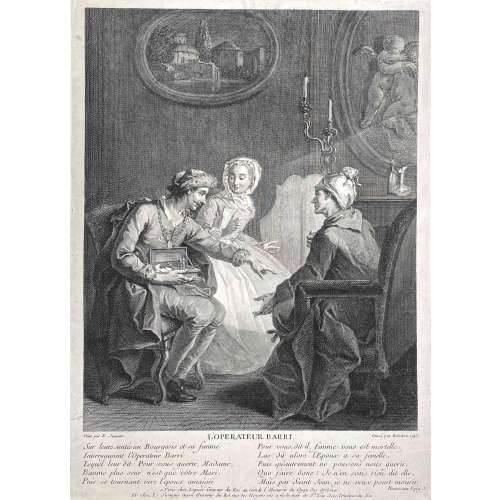
Engraving by J.J. Balechou after E. Jeaurat. A husband and wife ask a quack doctor for advice about health: he suggests substituting himself for the husband in the wife's affections, and she agrees: Épigrammes de Jean-Baptiste Rousseau (French, 1671–1741).
Date: 1743.
Size: 380 x 270 mm
Inscriptions under the image:
Top: Peint par E. Jeaurat | L'Operateur Barri | Grave par Balechou 1743
Middle: Sur leurs santés un Bourgeois et sa femme
Interrogeoient l'Operateur Barri, Lequel leur dit : Pour vous guérir, Madame, Baume plus sûr n'est que votre Mari, Puis se tournant vers l'époux amaigri, Pour vous, dit il, femme vous est mortelle, Las ! dit alors l'Epoux à sa femelle, Puis qu'autrement ne pouvons nous guérir, Que faire donc ? Je n'en sçai rien, dit elle,Mais, par Saint Jean, je ne veux point mourir.
Rousseau Epig. X
Center bottom: a Paris chez Lepicie Graveur du Roi au coin de l'Abreuvoir du Quay des Orfevres. Et Chez L. Surugue Aussi Graveur du Roi rue des Noyers vis a vis le mur de St. Yves Avec Privilege du Roi. -
 Woman Looking out a Round Window at a Woman with a Komusō Hat.
Woman Looking out a Round Window at a Woman with a Komusō Hat.Artist Koikawa Harumasa (a.k.a. Banki): fl. 1801–18. Wikipedia: Koikawa Harumasa (恋川 春政; active 1800–1820), later called Banki Harumasa (晩器 春政). Associated with Katsukawa school.
Signed: Banki ga (on the bamboo flower container in the background). Censor's seal: kiwame. Mark of unidentified publisher, Genshoku #1017; Marks U084 Ibiko, p. 387.
References:
Jacob Pins #828.
-
 Ebisu drawing wakamizu, the first water drawn from a well on the New Year. Kitao Shigemasa (北尾 重政, 1739 – 8 March 1820). Signed: Shigemasa. Publisher's mark: Nishimuraya Yohachi.
Ebisu drawing wakamizu, the first water drawn from a well on the New Year. Kitao Shigemasa (北尾 重政, 1739 – 8 March 1820). Signed: Shigemasa. Publisher's mark: Nishimuraya Yohachi.References:
Jacob Pins #547 [p.217] - Ebisu drawing wakamizu, the first water drawn from a well on the New Year. TNM II (Tokyo National Museum Catalogue vol. 2) #1373.
-
 Santō Kyōden (山東 京伝, September 13, 1761 Edo – October 27, 1816) was a Japanese poet, writer and artist in the Edo period. He studied ukiyo-e under master Kitao Shigemasa (北尾 重政) [see SVJP-0006], and began illustrating kibyōshi under the pseudonym of Kitao Masanobu (北尾 政寅).
Santō Kyōden (山東 京伝, September 13, 1761 Edo – October 27, 1816) was a Japanese poet, writer and artist in the Edo period. He studied ukiyo-e under master Kitao Shigemasa (北尾 重政) [see SVJP-0006], and began illustrating kibyōshi under the pseudonym of Kitao Masanobu (北尾 政寅).Signed: Masunobu ga.
"Parody of the Nō Play Chōryō" (elsewhere) or "Parody of Huáng Shigōng and Zhāng Liáng" (David Waterhouse, The Harunobu Decade, Hotei Publishing, 2013, v. 2, №651). "The story [...] is about an encounter between the Chinese government minister Chôryô (Zhāng Liáng) and the legendary elder Kôsekikô (Huáng Shigōng) in the 3rd century BC. While riding a mule across a bridge, Kôsekikô dropped his sandal. Chôryô returned it to him. As a reward, Kôsekikô gave Chôryô a book of military strategy. Later, Chôryô helped to establish the Han Dynasty (207 BC-AD 220)." [The Walters Art Museum]References:
Waterhouse, The Harunobu Decade (2013), #651; Ukiyo-e shûka supp. 2 (1982), pl. 625; Pins, The Japanese Pillar Print (1982), #274/p.145; J. Kurth, Die Geschichte..., vol. II, Leipzig, 1928; S. Kikuchi, Ukiyo-e, 1966.
-
 Kikukawa Eizan (菊川 英山, 1787 – July 17, 1867) Signed: Eizan hitsu (英山筆)
Kikukawa Eizan (菊川 英山, 1787 – July 17, 1867) Signed: Eizan hitsu (英山筆)Jacob Pins #972/p.341. Leiden, Rijksmuseum voor Volkenkunde.
"The Lovers Miura-ya Komurasaki and Shirai Gonpachi: Tragic love stories taken from real life and dramatized were a staple of stage and print; the darkly romantic combination of desire and death was hugely popular in the eighteenth century. Hirai Gompachi was a warrior of the Tottori fief in western Japan who fled to Edo after committing a murder. He was apprehended and sentenced to death in 1679. His distraught lover, the courtesan Komurasaki, committed suicide at his grave." [MET]
.
-
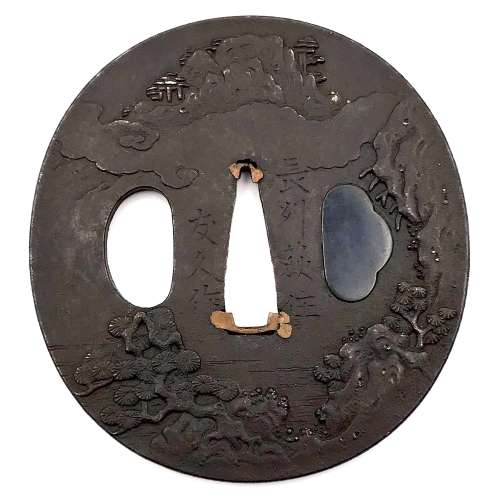
Iron tsuba of oval form carved with a landscape motif. Kogai-hitsu-ana plugged with shakudo. Sekigane of copper.
Signed: Chōshū Hagi-jū Tomohisa saku (長州萩住友久作).
Tomohisa, adopted son of Rokurō'emon, was 3rd generation master of Kawaji School from Hagi in Nagato (Chōshū), lived 1687-1743 [M. Sesko 'Genealogies', page 117].
Edo period, circa 1700. Dimensions: 71.1 x 66.8 x 2.9 mm For his adopted son Hisatsugu work see TSU-0103 in this collection. -

Iron tsuba of circular form with a branch of loquat (biwa) pierced in positive silhouette (ji-sukashi) and carved in marubori technique (marubori-sukashi). Kozuka and kogai hitsu-ana are plugged with shakudo.
Signature: Choshu Kawaji ju Hisatsugu saku. Chōshū school in Nagato province.
According to M. Sesko 'Genealogies' Hisatsugu was a 4th generation Kawaji School master from Chōshū (present day Nagato), with the name Gonbei, formerly Toramatsu, adopted son of Tomohisa (1687-1743) [page 117]. For Tomohisa work see TSU-0104 in this collection. -
 The Seven Gods of Good Luck in the Takarabune (ship of fortune) with a crane (the phoenix) above them.
The Seven Gods of Good Luck in the Takarabune (ship of fortune) with a crane (the phoenix) above them.Attributed to Katsukawa Shunshō, fl. 1726–92. Publisher: Uemura from Shiba (Edo). Marks "Publishers": U361|25-300: Uemura han (1793-1813). Marks "Artists, publishers...": Emiya Kichiemon (1688-1835). Artist signature absent. Looks very much like Pins #565 [p.223], but NOT the same. This exact design has not been found anywhere.

-
 Katsukawa Shunshō ( 勝川 春章; 1726 – 19 January 1793).
Katsukawa Shunshō ( 勝川 春章; 1726 – 19 January 1793).Signed: Katsukawa Shunshô ga (勝川春章画).
The size is somewhat larger than the standard pillar print (hashira-e): 16.3 x 67.7 cm.
No references found so far.
-
 Katsukawa Shunshō ( 勝川 春章; 1726 – 19 January 1793).
Katsukawa Shunshō ( 勝川 春章; 1726 – 19 January 1793).Signed: Shunchô ga (春潮画); Censor's seal: kiwame (改印:極)
Publisher: Iwatoya Kisaburō (Eirindō); c. 1760s – 1832. Marks #173/p.169.
Reference: MFA ACCESSION NUMBER 11.21263. Not in Pins.
Act VII, Gion Ichiriki no ba ("The Ichiriki Teahouse at Gion") This act gives a taste of the bustling atmosphere of the Gion pleasure quarter in Kyoto. Yuranosuke is feigning a life of debauchery at the same teahouse to which Okaru has been indentured. Kudayū, the father of Sadakurō, arrives. He is now working for Moronō and his purpose is to discover whether Yuranosuke still plans revenge or not. He tests Yuranosuke's resolve by offering him food on the anniversary of their lord's death when he should be fasting. Yuranosuke is forced to accept. Yuranosuke's sword – the revered symbol of a samurai – is also found to be covered in rust. It would appear that Yuranosuke has no thoughts of revenge. But still unsure, Kudayū hides under the veranda. Now believing himself alone, Yuranosuke begins to read a secret letter scroll about preparations for the vendetta. On a higher balcony Okaru comes out to cool herself in the evening breeze and, noticing Yuranosuke close by, she also reads the letter reflected in her mirror. As Yuranosuke unrolls the scroll, Kudayū, too, examines the end which trails below the veranda. Suddenly, one of Okaru's hairpins drops to the floor and a shocked Yuranosuke quickly rolls up the scroll. Finding the end of the letter torn off, he realises that yet another person knows his secret and he must silence them both. Feigning merriment, he calls Okaru to come down and offers to buy out her contract. He goes off supposedly to fix the deal. Then Okaru's brother Heiemon enters and, hearing what has just happened, realises that Yuranosuke actually intends to keep her quiet by killing her. He persuades Okaru to let him kill her instead so as to save their honour and she agrees. Overhearing everything, Yuranosuke is now convinced of the pair's loyalty and stops them. He gives Okaru a sword and, guiding her hand, thrusts it through the floorboards to kill Kudayū. The main actor has to convey a wide variety of emotions between a fallen, drunkard rōnin and someone who in reality is quite different since he is only faking his weakness. This is called hara-gei or "belly acting", which means he has to perform from within to change characters. It is technically difficult to perform and takes a long time to learn, but once mastered the audience takes up on the actor's emotion. Emotions are also expressed through the colours of the costumes, a key element in kabuki. Gaudy and strong colours can convey foolish or joyful emotions, whereas severe or muted colours convey seriousness and focus. -
 Katsukawa Shunshō ( 勝川 春章; 1726 – 19 January 1793).
Katsukawa Shunshō ( 勝川 春章; 1726 – 19 January 1793).SIZE: 12.5 x 5.75 in.
-
 Ichikawa Ebizō III (Matsumoto Kōshirō II, Ichikawa Danjūrō IV, 1711-1778) probably shown as Shinozuka Gorō in the Shibaraku scene of the play Ōyoroi Ebidō Shinozuka, performed at the Nakamura Theater in the 11th month of 1772 (Meiwa 9). This was the occasion when he celebrated his name change, from Matsumoto Kōshirō II to Ichikawa Ebizō III. The lobster or giant shrimp (ebi) upon the Ichikawa family crest (three concentric squares - three measures of rice) on his garment underscores the fact of the name change (ebizō).
Ichikawa Ebizō III (Matsumoto Kōshirō II, Ichikawa Danjūrō IV, 1711-1778) probably shown as Shinozuka Gorō in the Shibaraku scene of the play Ōyoroi Ebidō Shinozuka, performed at the Nakamura Theater in the 11th month of 1772 (Meiwa 9). This was the occasion when he celebrated his name change, from Matsumoto Kōshirō II to Ichikawa Ebizō III. The lobster or giant shrimp (ebi) upon the Ichikawa family crest (three concentric squares - three measures of rice) on his garment underscores the fact of the name change (ebizō). -
 Artist: Katsukawa Shunkō [勝川 春好] (Japanese, 1743 – 1812).
Artist: Katsukawa Shunkō [勝川 春好] (Japanese, 1743 – 1812).Actor: Matsumoto Kōshirō IV [[松本幸四郎]; other names: Omegawa Kyōjūrō, Ichikawa Komazō II, Ichikawa Somegorô I, Ichikawa Takejūrō, Segawa Kinji, Segawa Kingo] (Japanese, 1737 – 1802).
Signed: Shunkō ga. Size: Hosoban; 14 x 33 cm. SOLD


